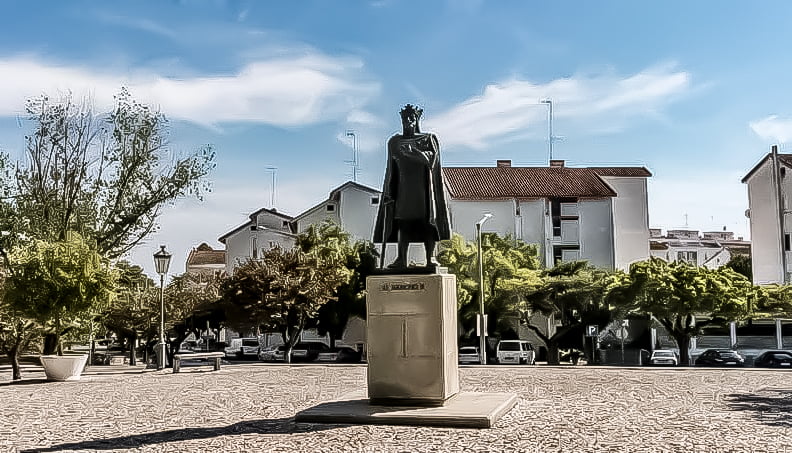Have you been to Elvas, Portugal, and seen the King Sancho II of Portugal statue? If so, you might be wondering who was King Sancho II. You could also wonder why he is vital to this rural location in the Alentejo region of Portugal.
We have discussed the reigns of Dom Afonso I and Sancho I. We have not confused you too much with Sancho I’s son, Dom Afonso II’s article.
I state this because many future Kings of Portugal will have similar names. This article will further develop this trend by discussing King Sancho II.
Obviously, this will be the second king named Sancho. Sancho II is the grandson of Sancho I and the son of Afonso II.
Only some individuals now recognize the name D. Sancho II, the fourth king of the new kingdom of Portugal. D. Sancho II suffered tremendous adversity and betrayal during his short rule.

Who was Dom Sancho II?
Sancho II demonstrated himself as a skilled commander but was negligibly adept in equally urgent organizational matters. His entire attention concentrated on military campaigns that presented opportunities for internal disputes.
The nobility was dissatisfied with the king’s behavior and started to conspire against him. At the same time, the middle class of merchants became disgruntled. They frequently clashed with the clergy without Dom Sancho I’s intervention.
As a result, the bishop of Porto produced a formal complaint to the Pope. The Church was still a dominant power in the 13th century. Pope Innocent IV felt free to issue bull Grandi non immerito, ordering the Portuguese to select a new king.
The strong resistance by the papacy, bishops, and minor nobility, D. Sancho ensured the conquest. The Moorish occupiers lost land as he seized much of the Alentejo and parts of the Algarve. The capture of Ayamonte also secured the Guadiana River’s access.
The possession of Ayamonte was a practical bargaining chip in future negotiations by his successor D. Afonso III with the king of Castile.
Summer sieges of this town and castles occurred, and bribes to the rowdy crusaders occurred from the captured town’s loot. Unfortunately, Portugal could not hold this remote conquest, and less than two years later, it fell again to a Moorish attack.

D. Sancho II’s Reign as King of Portugal
In 1223, at age 13, D. Sancho II came to power in Portugal and remained in power until he died at 38 in 1248. Under the shadow of his father’s ex-communication, D. Sancho had an unlucky beginning to his reign. He advised continuing the war against the Moorish kingdoms to appease The Pope. The Pope considered this war equivalent to a crusade against the Holy Land.
His forces were able to capture Mérida in 1230 and Córdoba in 1236. To the west of Guadiana, Later Portuguese forces occupied Elvas in 1230, Serpa in 1232, Mértola in 1238, and Cacela and Tavira in 1239.

Rewarding Order of Knights for their Conquests
It is essential to remember the services of a standing army were not maintained by medieval kings. In Castile and Portugal, many aggressive forces originated from the Military Orders of knights’ activities. Kings, however, did pay these knights for their services.
Sancho II rewarded the Order of Santiago by offering them Alcácer do Sal. The new Portuguese headquarters for the Order of Santiago was instrumental in future strategic battles in the Alentejo and the Algarve and parts of Andalusia.
Despite the military successes in the Alentejo, D. Sancho could not establish his command over the territory. There was also a refusal to accept royal authority, even among the king’s family.
Porto and Lisbon’s bishops brought bitter complaints against the crown for encroachment on the property of their dioceses. By 1241, Braga, Lisbon, and Porto clerics were all in Rome, telling the Pope of tainted accounts of their king.

Pope Innocent IV Power over Portugal and King Sancho II
Pope Innocent IV was recently elected and anxious to impose his authority. He summoned D. Sancho II to leave his new wife, D. Mécia Lopes de Haro, and charged him with perpetrating crimes.
Pope Innocent mandated the Portuguese people to furnish the kingdom with a more deserving ruler. He named the favored successor, the king’s younger brother Afonso III.
D. Afonso promised to restore good to Portugal and to set aside the bad innovations of his brother and father. What he was saying is he would obey the Pope and protect the Church in Portugal.
Fernando III, King of Castile, remarked that the Pope had arrogated supremacy over the kingdom of Portugal. It must have come as a shock to D. Sancho II when the Order of Santiago chose to side with the usurper rather than with the king who had so generously rewarded them.
These kingdoms had done much of the work of reconquest during his reign,
When D. Afonso III reached Lisbon in early 1246, support occurred by order of Santiago and Lisbon concelho. He proclaimed himself the “Procurator of the Kingdom” and “Defender and Visitor of the Kingdom for the Supreme Pontiff.”
The northern parts of Portugal stuck with D. Sancho, while the south declared allegiance to his brother, the usurper. The supporters of D. Afonso III eventually kidnapped the queen, who could now not bear a legitimate child. Thus, the king had no hope of a son and successor.
D. Sancho II was disgusted at how his brother had treated him. Like his father before him, he began to suffer from poor health, and, recognizing the inevitable, he retreated to Toledo, chaperoned by his Chancellor and a few loyal supporters.
Dom Sancho II’s Death

The unfortunate D. Sancho II died in early 1248, and, at last, D. Afonso III was officially announced the King of Portugal.
The castle at Coimbra persisted in holding out against D. Afonso III, and the tale of its surrender is a part of Portuguese legend. D. Sancho II had appointed Martim de Freitas governor of Coimbra. Martim’s loyalty to D. Sancho II was held through the promises to maintain the castle for his lord.
While Coimbra’s Castle does not stand today, Martim’s refusal to surrender did not see its ruin.
After a siege of two years, the besiegers informed Martim that Sancho II had died at Toledo. He did not believe his enemies and demanded safe passage to Toledo. There he requested that D. Sancho’s casket be open so he could first authenticate that D. Sancho was dead and second surrender the keys of Coimbra to his new lord.
Taking the remains of Sancho II back to Coimbra with a clear conscience, he offered the castle of Coimbra to the new king D. Afonso III.
While D. Afonso III is remembered for his part in conquering the Algarve, few remember his less-than-glorious method of ascending the throne through disloyalty to his brother.

Portugals Coats of Arms
The Portuguese flag possessing seven castles has nothing to do with the number the castles conquered in the Algarve. The mysticism is a basis for a fantasy invented in early modern times.
Heraldic usage shows a simple reason for the border of castles around the royal arms.
His eldest surviving son inherited the coat of arms at Sancho II’s death D. Sancho II inherited his father D. Afonso II’s royal arms. When D. Sancho II’s younger brother, D. Afonso III, took power, he created a different set of arms. He did so to show the royal lineage.
The adversarial role with Pope Innocent IV meant he could not use the same arms as D. Sancho. Afonso III had ties to the crown of Castile because his mother was Castilian. His Castilian heritage is why he selected the Castilian castle border around his father’s arms.
This new design had 16 castles on the monarch’s arms. The modified components were in use for 140 years. Then they changed the royal arms again at the accession of D. João I in 1385.
The quantity of Portuguese castles on the royal arms has changed over time. Therefore, the visual of the number of castles appear standardized at seven only after the accession of D. João III in 1521.
The Atypical Last Line
The Monarchy in Portugal can be challenging to understand with all these Portuguese Kings with the same name and roman numerals attached. So, separating these kings’ histories helps us appreciate their conquests in defining Portugal.
Sancho II’s reign through the Portuguese House of Burgundy primarily definition was through the internal fighting within the house. The main point to remember is Pope Innocent IV’s involvement in appointing Sancho II’s brother Afonso III to power.
However, Sancho II was very successful in his military conquests against the Moors. He appointed the Order of Santiago, a ruling body over Alcácer do Sal. The Order appreciated the offering but eventually betrayed Sancho II’s trust by the mandates of Pope Innocent IV.
If you are new to Atypical Vagabond sign up for newsletter to read up to date content.
Subscribe
Are you an avid traveler seeking inspiration for your next adventure? Look no further than the Atypical Vagabonds newsletter. By subscribing to our newsletter, you gain access to a treasure trove of travel tips, destination guides, and captivating stories from around the globe. Our expertise in exploring off-the-beaten-path destinations. We offer a refreshing perspective on travel, encouraging you to embrace the unconventional and discover unique experiences. Join the community today and let our wanderlust-inducing content inspire you. Therefore, you can embark on extraordinary journeys. Subscribe to receive their latest updates directly in your inbox and never miss a travel adventure again.
Donations
Love what you’re seeing on Atypical Vagabond? Help us keep the adventures coming! Consider donating through PayPal’s secure payment system. Every contribution goes a long way in fueling our mission to bring you more thrilling content and unforgettable experiences. Join us in shaping the future of travel—donate today!




[…] Sancho II (birth 1209 – death 1248) […]